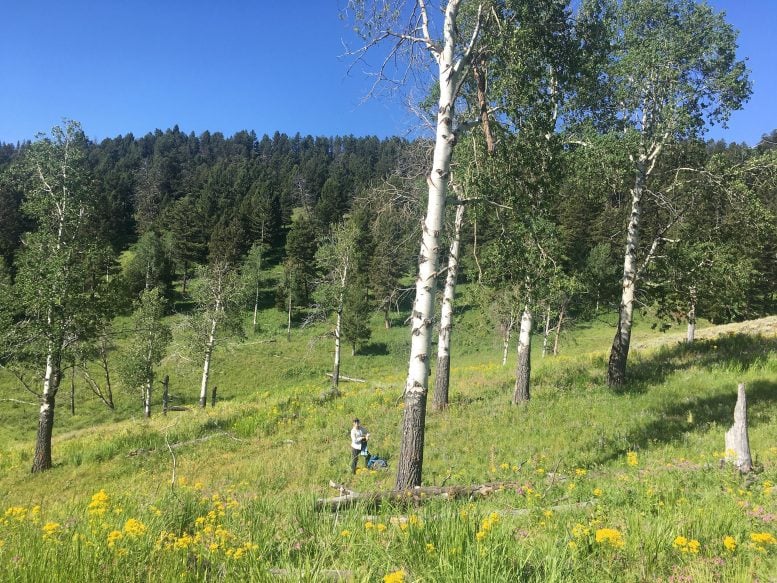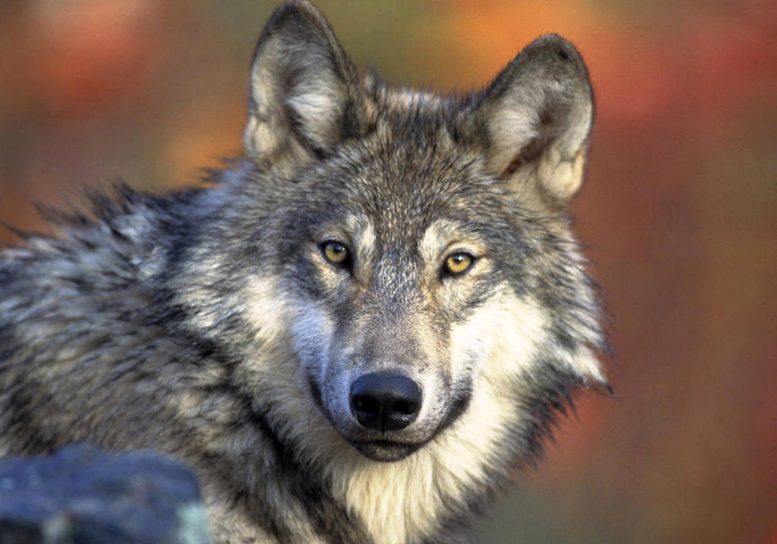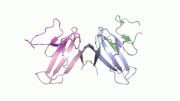New research shows that the effects of wolves on the recovery of aspen has been exaggerated by how it was measured.
It’s an environmental success story that feels like a parable—the reintroduction of wolves in Yellowstone National Park in the mid-1990s triggered a cascade of effects that ultimately restored the ecosystem, including the recovery of aspen trees. But like many stories based on ecological realities, it’s more complex than at first glance—aspen recovery in the park is not as robust as generally believed, according to new research published in Ecology Letters.
The Yellowstone story is a textbook example of a trophic cascade, in which predators help plants grow by eating or scaring away herbivores that eat the plants. When wolves were reintroduced into the Yellowstone food chain, they helped to reduce the number of elk, which had been consuming young aspen trees. Previous research showed strong positive growth in young aspen as the elk populations decreased—a welcome result, as aspen forests have been vanishing from the northern Yellowstone landscape for the last century.
But new research from Elaine Brice and Dan MacNulty, from Utah State University’s Department of Wildland Resources and Ecology Center, and Eric Larsen, from the University of Wisconsin Stevens Point’s Department of Geography and Geology, shows that the effect of wolves on the recovery of aspen has been exaggerated by how it was measured.

Previous research showed strong positive growth in young aspens in Yellowstone National Park as the elk populations decreased—a welcome result. But new research shows aspen recovery is not as robust as previously thought. Credit: Photo Courtesy Lainie Brice
Previous studies evaluated aspen recovery in Yellowstone by measuring the five tallest young aspen within a stand. The reasoning was that the tallest young aspen trees represent a ‘leading edge’ indicator of the future recovery of the entire aspen population. But this is not the case—sampling only the tallest young aspen estimated a rate of recovery that was significantly faster than was estimated by random sampling of all young aspen within the stand, according to the research.
“These are extremely complex systems, and understanding them is a major challenge because they are difficult to properly sample,” said Brice. “The traditional method of sampling by only using the tallest young aspen plants to measure growth—which most research currently relies on—doesn’t capture the entire picture.”
For one, elk are picky about the aspen they consume. They tend to eat plants at shoulder height for which they don’t have to crane their necks. As the leader stem (main trunk) of a young aspen grows past the shoulder height of adult elk, it is decreasingly likely to be eaten as it grows taller, said MacNulty. “This means that the tallest young aspen grow faster because they are taller, not because wolves reduce elk browsing,” said MacNulty. This finding highlights the complicating fact that the height of young aspen is both a cause and an effect of reduced elk browsing.
Taller aspen also thrive because they tend to have the best growing conditions (sunlight, moisture, soil quality). Measuring just the tallest young trees downplays the role of these other factors that have nothing to do with elk or wolf populations. And measuring just the tallest aspen also overlooks the failure of some young aspen to regenerate in the first place.
“That’s like calculating a team’s batting average without the player who always strikes out,” said Brice. Random sampling from the research showed an absence of aspen regeneration in some places, a vital piece missing from the initial measurements.
Understanding how ecosystems respond to changes in large predator populations is vital to resolving broader debates about the structure of food webs, determining species abundance, and delivering ecosystem services, said the authors. This study demonstrates how deviations from basic sampling principles can distort this understanding. Non-random sampling overestimated the strength of a trophic cascade in this case, but it may underestimate cascading effects in other situations. Randomization is one of the few protections against unreliable inferences and the misguided management decisions they may inspire, they said.
“The bottom line is that ecologists must stick to classic principles of sampling design, like randomization, to fully understand trophic cascades in complex wildlife systems like Yellowstone,” said MacNulty.
Reference: “Sampling bias exaggerates a textbook example of a trophic cascade” by Elaine M. Brice, Eric J. Larsen and Daniel R. MacNulty, 8 November 2021, Ecology Letters.
DOI: 10.1111/ele.13915
[Editor’s note: The header image has been changed. The original was a coyote, not a wolf.]










Why is this article accompanied by a photo of a Coyote?
Thanks for the note. The image has been changed.
The original image was listed as a wolf, not a coyote, in our image library. I didn’t know enough about the differences to realize it was wrong. The new one comes from the U.S. Fish and Wildlife Service.
The photo anchoring the story is that of a Coyote, not a Wolf! If you’re going to present an environmental story regarding one of the impacts on the ecosystem of Yellowstone brought on by the reintroduction of wolves, you should probably have someone who actually knows what a wolf looks like approve the final edit….
The feature photo is a coyote, not a wolf. The authors of the research article did not provide this erroneous photo.
Correct. The mistake was entirely on me editing at ScitTechDaily.com and not at all with the authors of the study.
I was an activist for wolf recovery programs in the 1980s. I also visited Yellowstone Park before the fires of 1988. I did some random offtrail backcountry traversing and saw numerous fallen trees, as well as elk carcasses that were unscavenged. It was shocking and stuck in my mind due to the perception of waste and imbalance in the park. A lot has changed since then, for the better.
In this highly politicized Era, I can’t help but think this study is motivated by the growing lobby of hunters who want to kill off wolves again and are looking for ways to justify their murderous impious stewardship.
The method of measuring stands is the same used traditionally and throughout ecological surveys. Why now regarding wolves should this method be questioned? Why not reconsider it for the effects of industrial impact, or commercial lumber, or the effects for building new roads?
Was this study funded by ranchers who like to kill wolves?
The integrity of the study suffers enormously when the authors apparently can’t tell the difference between a wolf and a coyote.
I’m sure the authors of the study know the difference very well.
The mistake was entirely my fault, as I edited the article and selected the header image. Unfortunately, even after reading up on the subject, I still can’t reliably distinguish between wolves and coyotes.
That’s a Coyote btw
In all of the comments I did not see anyone state which state that they live in! Unless you and your family live where there are wolves you should probably reconsider your views. Oh yah! I’m sure that the person who posted the coyote picture was not from Idaho or the surrounding states. I am a Idaho resident and hunter.
The wolf’s hiding in the bushes, waitin’on kicking that coyote’s butt. They’re hard to spot, just like north American house hippos.
Wolves rule, let them be. Coyote’s are a damn nuisance (though they do kill rodents) that adapt anywhere & everywhere, including downtown. Cross breeds are another story.
Feral domestic dogs are the most unpredictable.
Some love for them all though…
This article was written by pro wolf killers.I live in Florida , been to Yellowstone 20 times since the late 80’s.Ive seen the improvement.These people are like
abortionist who murder the unborn in the womb.They just want to kill kill kill. Screw trophy hunters.Protect wolves and bears in all 50 states.Prison for killing wolves and bears and human babies.How bout hunters in woods hunting wolf killers think bout that.Montana governor breaks own states hunting laws , he is a wonderful example of an out and out selfish ass.Vote him out Montana.